Comparative Study on the Efficiency of Women Tennis Players’ First Serve at Australian Open 2014 and 2015
Abstract
Women’s tennis is focused now on increasing the fixed phase. The fixed phase is regarding the serve and the return of serve. Therefore, tennis coaches are working on finding new methods to increase the efficiency of this phase. The alternative phase, meaning every stroke after the return, is well developed for the majority of women tennis players. Thus, the fixed phase might be the clue of the next level in performance tennis. Several specialists described in literature the efficiency of tennis serve. The risk assumed by the player during these shots was placed at the heart of this strategy. In this paper, we intend to compare the efficiency of the first serve and winners after the first serve of women tennis players at the Australian Open 2014 and 2015. We want to underline if the efficiency of the first serve is on a high level at the beginning of a competition year and if this aspect was developed from 2014 to 2015. This study used specialized documents and the method of statistical analysis of the data. The data were provided by the Australian Open statistics. Variables taken into consideration were the effectiveness of the first serve (the ratio between the number of successful service in total effectuated services) in 45 games in the 2014 and 2015 Australian Open Tournament, and the efficiency of winning a point after the serve (the ratio of points won in total returns after the first serve).
Keywords: Tennis efficiency, first serve, serve strategy, women tennis players, WTA Grand Slam tournaments
1. Introduction
Women’s tennis circuit feels the influence of men’s tennis, which is manifested lately by the
emphasis on the fixed phase of the game. The fixed phase consists of service and return of service, and
since the fixed phase ensures rapidly winning the point, experts want to render it more efficient in
women’s tennis too. In the Australian Open, the service could be a decisive factor in winning matches
because the event is held on a fast surface, Plexicushion, which highlights the efficiency of the service.
As far as the service is concerned, there is a wish to see its speed and placement considerably
improved during training, with concrete results in the competitive game (Pollard et al., 2009).
Specialists focus on the following efficiency factors in service, namely in the first serve on speed
and placement, and in the second serve on effect and direction (Antoun, 2007; Knudson et al., 2004).
Also, the return of service can be a weapon that WTA players can take full advantage of - if they want
to finish the game in a short time, and take advantage of a weak service of the opponents (Blackwell &
Cole, 1994).
A previous study (Stănescu, 2014) has shown that the service is not a decisive factor in winning the
Grand Slam tournament matches analysed, as the first serve has fairly large fluctuations from one
round to another, and even at the highest level in women’s tennis service is not yet a shot to tip the
scales in order to win a match. It has also been revealed that the best results, in both first serve and first
point after the serve, are recorded in the first round. This reinforces the argument that insufficient
physical and mental preparation leads to rather large variations in results as they are advancing in the
tournament.
1.1. Content of the fixed phase in women tennis
Under these circumstances, coaches have begun to put more emphasis on the fixed phase in training,
compared to the alternative phase. The alternative phase is well represented among the WTA women
tennis players, with a similar level in terms of the top players. Therefore, the fixed phase can be the key
to success in the next stage of women’s tennis development.
Regarding thethe women tennis players have to choose among three (3) types of execution
which give them great efficiency during the game:
The first is the, which is preferred by the tall players having a great execution speed so that the ball gone from their racket speeds between 170 and 200 km/h;
A second way is the, which, due to the imprinted effect, after the ball touches the ground, bounces high and increases the difficulty of the shot;
A third alternative is the, which is a very safe process, and by the placement, it can be a very useful weapon in women’s tennis.
The can also have several variations, depending on the chosen strategy:
the aggressive return, which translates into a decisive ball with placement, but also with speed and force to get the point;
the long median return, in the centre, for safety and to not give the opponents the opportunity to open the angles of the game;
the side return, to move the opponent and create the possibility to advance to the net; this way is chosen by offensive players who often arrive at the net to get points.
2. Research methodology
The purpose of this study is to highlight the influence of the efficiency of the first serve on the
results of the women tennis players at the Australian Open. In this regard, the first serve efficiency was
compared to the efficiency of the first ball after service at the Grand Slam Tournament, Australian
Open, in 2014 and 2015.
2.1. Research methods
In this paper, there were used data provided by specialized websites of the Australian Open
Tournament and the International Tennis Federation showing the statistical records of the results from
the above-mentioned tournament. For data analysis, we compared the percentages of success
percentages in the fixed phase of the game, and we correlated them with the results of the games and
tournament. The variables taken into consideration were the first serve efficiency (the ratio between the
number of successful services and the total number of services) and the efficiency of the first point
after service, in 45 games at the Australian Open 2014 (22 games) and 2015 (23 games).
2.2. Subjects
In this regard, we analysed the results of the finalists in the two years (2014 and 2015) and the two
best results of the players from Romania who participated in this tournament. The research has linked
the results of seven (7) WTA players.
3. Results and interpretation
A comparative analysis of the values of the two variables for the players mentioned, in 2014,
emphasized the following:
- the efficiency of the first serve, from round 1 to the final, recorded the following variations: for Na
Li - between 60% and 80%, for D. Cibulkova - between 60% and 77%; for S. Halep - between 52%
and 67%, and for M. Niculescu - between 64% and 82%; the service efficiency varies from one round
to another for both the finalist players and the Romanian players;
- the most effective first serve belongs to M. Niculescu, in the 1st round, while the lowest is for S.
Halep, in the 3rd round (Table 1).
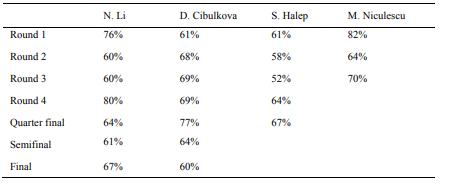
Applying the Student’s T-test to calculate the significance of the difference between the averages
recorded by the finalists has indicated a t-value = 1.71, which allows us to say that the difference is not
significant at p = 0.05. The same indicator, from the comparison of the Romanian players, offered us a
t-value = 3.27, also not significant at p = 0.05. We can state that, regardless of the ranking achieved,
there were not any significant differences in terms of service efficiency.
The highest efficiency of the first point after the first serve belongs to S. Halep, with 84% in round
1, while the same player has the lowest efficiency, 45%, in the quarterfinals (Table 2, Graph 2). Graph
2 shows that, throughout the tournament, this variable described a downward curve: for the winner
from 71% to 59%; for the finalist from 75% to 58%; for S. Halep from 84% to 45%, and for M.
Niculescu from 58% to 50%.
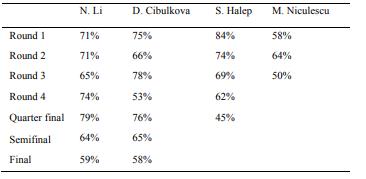
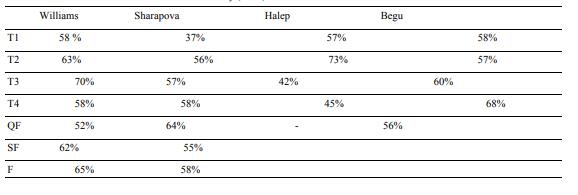

3.1. Analysis and interpretation of the data
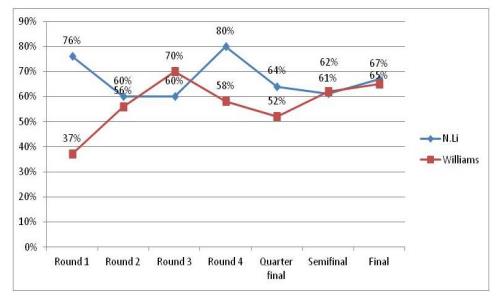
At the 2014 tournament, for the service, the average percentage of the tournament winner was 66%,
with a minimum of 60% and a maximum of 80% compared with the 2015 winner, who averaged 61%,
with a minimum of 52% and a maximum of 70%.
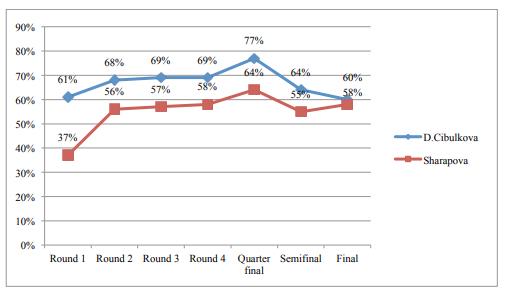
Regarding the 2014 finalist, she had an average of 66%, with a minimum of 61% and a maximum
of 77%, and the 2015 finalist had an average of 55%, with a minimum of 37% and a maximum of 64%.
206
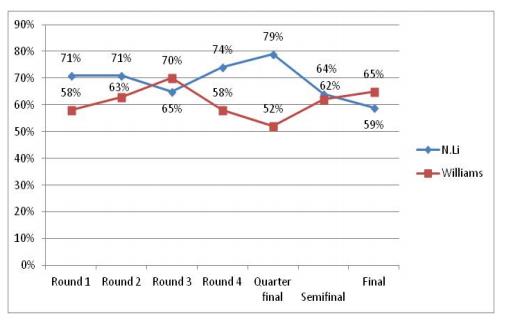
Regarding the average percentage for the first shot after service, the 2014 winner had 69%
compared with the 2015 winner who had an average of 76%.
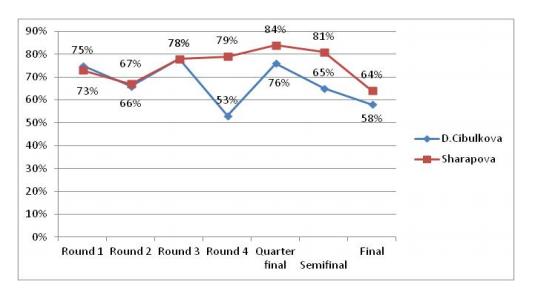
The finalists obtained an average percentage of 67% in 2014, and in 2015 they obtained 75%. S.
Halep got 66% in 2014, and in 2015 she got 74%.
Thus, regardless of the performance level, in 2014 the first point after service tends to be less
efficient from one tour to another. The application of significance tests between the finalist players and
the Romanian women players allowed us to find the same values, insignificant at p = 0.05, for the t
variable.
Among the Romanian tennis players, S. Halep was present both in 2014 and 2015 in superior
phases, and she had the following results for the service: in 2014 she had an average of 66%, with a
minimum percentage of 45% and a maximum of 84%, getting in the quarterfinals; in 2015 she had an
average of 74%, with a minimum percentage of 67% and a maximum of 79% getting only in the fourth
tour. The other player, M. Niculescu from Romania, in 2014 had an average of 57%, just like I. Begu in 2015, who had 57% too. Compared with M. Niculescu, who got only in the 3rd tour, I. Begu got into
the quarterfinals.
In conclusion, the efficiency of the service decreased in 2015 compared with 2014, so we believe
that the finalists had other strengths to reach the final act of the Australian Open.
This conclusion is underlined by the fact that the identical percentage of our players (57%) led to
better performance in 2015 than in 2014 (I. Begu in the quarterfinals compared with M. Niculescu,
who only got in the 3rd round). However, compared to the serve, the efficiency of the first ball after
service increased significantly from 2014 to 2015, by almost 10%. The graphs show that both winners
had, in the final percentages at the service, an upward curve, and for the 2015 winner, the percentage of
the first ball after service was upward compared with the winner of the next year, for whom this
percentage was downward. Regarding the finalists, only one had the percentage at the service on an
upward curve compared to the other one, who had this figure on a downward curve. In terms of
efficiency of the first ball after service, both were evaluated in the downward zone. Also, both Halep,
in 2014 and 2015, and Begu, in 2015, were eliminated from the tournament when they were on a
downward curve at the service.
4. Conclusions
In conclusion, it is obvious that all the prerequisites to winning the games, especially in the final
stages, are met when most of the game efficiency parameters (including the service and the first ball
after service) are growing. We also note that there are two peaks of efficiency during the two-week
Grand Slam tournament compared to normal one-week tournaments, peaks that specialist teams should
obtain so that the second one would be in the final stages. The two areas of minimal efficiency (that
specialists should manage so that players have optimum efficiency that would ensure winning the
games) are of paramount significance.
The increased percentage of the service efficiency, alone, does not guarantee winning the game but
the decreased percentage turns out to be decisive. Also, the percentage of the first ball after service
turns out to follow the same variation as the first serve efficiency. The fixed phase of the game must be
prepared as a whole, with the first ball after service so that both components have a maximum
percentage that could matter in winning a game or tournament. The physical and mental preparation
should also be intensified because these two training components lead to this variation in the efficiency
of these two strokes, and the tennis players have demonstrated that on the upward curve they obtain
impressive percentages. It should be researched whether these parameters can be maintained
throughout the two weeks, or the training sessions in the pre-competitive periods should be modelled
based on the two peaks of fitness appeared in the Grand Slam tournaments.
References
Antoun, R. (2007). Women’s Tennis Tactics. Champaign, Illinois: Human Kinetics.
Blackwell, J. R., & Cole, K. (1994). Wrist kinematics differs in expert and novice tennis players performing the backhand stroke: Implications for tennis elbow. Journal of Biomechanics,27(5), 509-516.
Knudson, D., Noffal, G., Bahamonde, R., Bauer, J., & Blackwell, J. R. (2004). Stretching has no effect on tennis serve performance. Journal of Strength & Conditioning Research, 18(3), 654-656.
Pollard, G., Pollard, G., Barnett, T., & Zeleznikow, J. (2009). Applying match statistics to increase serving performance. Journal of Medicine and Science in Tennis, (14)3, 16-19.
Stănescu, R. (2014). Study about the efficiency of first serve in Grand Slam tournaments for women tennis players. International Congress of Physical Education, Sports and Kinetotherapy, UNEFS, Bucharest.
Copyright information

This work is licensed under a Creative Commons Attribution-NonCommercial-NoDerivatives 4.0 International License.
About this article
Publication Date
10 June 2016
Article Doi
eBook ISBN
978-1-80296-010-5
Publisher
Future Academy
Volume
11
Print ISBN (optional)
-
Edition Number
1st Edition
Pages
1-509
Subjects
Sports, sport science, physical education
Cite this article as:
Stănescu, R. (2016). Comparative Study on the Efficiency of Women Tennis Players’ First Serve at Australian Open 2014 and 2015. In V. Grigore, M. Stanescu, & M. Paunescu (Eds.), Physical Education, Sport and Kinetotherapy - ICPESK 2015, vol 11. European Proceedings of Social and Behavioural Sciences (pp. 202-209). Future Academy. https://doi.org/10.15405/epsbs.2016.06.28

